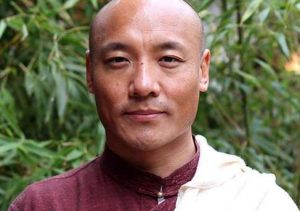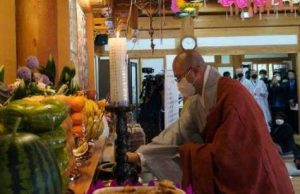Young Voices is a special project from Buddhistdoor Global collecting insightful essays written by high school students in the US who have attended experiential-learning-based courses rooted in the Buddhist teaching. Running in parallel with BDG’s Beginner’s Mind project for college students, Young Voices offers a platform for these students to share essays expressing their impressions and perspectives on their exposure to the Buddhadharma and its relationship with their hopes, aspirations, and expectations.
Chris Wong wrote this essay for his Global Buddhisms class at Phillips Andover, a high school in Massachusetts.

A Prescription for Digital Millennials: Sanghas
I used to take refuge in my phone. Time and time again I am told the perennial tale that the smartphone—I call it my dopamine machine—is causing the human species to lose touch with nature, with our communities, and, ultimately, with ourselves. To that, I ask how can we better use these metal and glass boxes?
As a high school senior and Buddhist empathizer, I am in a unique position to ask myself this very question; phones are at the center of teenage socialization, and Buddhism gives me tools for self-examination. Fortunately, thanks to a class assignment, I had the opportunity to detach from my phone for a week, use the time to reflect on my usage, and perhaps discover how Buddhist wisdom can help address my attachment to my phone.
Recently, I’ve been taking a class called Global Buddhisms, which looks at the diversity of Buddhist practices throughout the world. On one of our introductory texts, we went over Yongey Mingyur Rinpoche’s work In Love with the World. Specifically, my class had been dwelling on his experience of leaving Tergar Monastery in Bodh Gaya to begin a wandering retreat, along with the concept of “adding wood to the fire” in his journey.
The Tibetan expression “adding wood to the fire” is a practice of learning to harness one’s inner resources to deal with changing external circumstances, or learning to “deliberately [increase] the challenges of maintaining a steady mind.” (Mingyur, 5)
Inspired by Mingyur Rinpoche’s reflections, my class was urged to embark on a contemplative experience of our own, adding wood to our own metaphorical fires in order to learn to face the embers. Some of my peers gave up music for a week and some meditated, but I thought that giving up my smartphone was an easy choice. I knew that my phone consumed my life and provided comforting doses of dopamine whenever the world threw its challenges at me, but I understood little about my relationship with this device. I also hoped to find some answers about the root of phone use in my bout of ascetic practice, and perhaps discover what insights Buddhism might offer to this looming question. Plus, most of the rest of my class did it too.
I’d be lying if I said that giving up my phone was the hardest thing I’ve done in my life. Sure, there were moments of silence and solitude that felt like an uphill climb, but those moments of unease were short-lived. What was most surprising was that the relinquishment of my phone felt like more of a communal practice than a personal one.
At the get go, I took on this assignment partly due to the influence of peers. There was a comfort that radiated from the eagerness of my peers who also took on the challenge of giving up their smartphones. They helped to plant the seeds of courage that urged me to join them. As I pushed on through the week, I also found that it was my peers who reaffirmed the importance of my practice for me. They were shields that protected me from the looming feelings of judgment that I expected from the onlookers to this practice. As my dedication to adding wood to the fire waned, they supported me by asking about my experience. In reciprocation, I shared my ear to hear about their struggles. Throughout this experience, my sangha was the most important element to the success of my practice.
Thich Nhat Hanh writes beautifully about the sangha as a community of people who are supportive in mindfulness and provide a place of harmony, understanding, awareness, and love. (Hanh, Lions Roar) For me, a sangha is not merely made up of friends in Buddhist practice. They are the people who unconditionally provide support in mutual growth. I deeply resonate with Thich Nhat Hanh’s teachings on the Noble Eightfold Path, which, he emphasizes, “is the practice of our daily lives, not of intensive retreats alone.” (Hanh, The Mindfulness Bell)
My phone is often the escape I turn to in the idle discomfort of lunch lines, or in the looming silence of my dorm room. My phone takes me away from the physicality of daily life and of human interactions, so taking away my phone forces me to reconcile with these uncomfortable forces. By viewing the practice of relinquishing my phone through Thich Nhat Hanh’s teachings, it becomes a Buddhist practice of right mindfulness and right effort, in which my sangha also becomes the community that enriches my practice. So although my sangha isn’t necessarily composed of people seeking to attain enlightenment, they support my practice in daily life through love and understanding, and, ultimately, that is the practice that is the most important.
So what are my takeaways on the issue of attachment to digital devices? I used to assume that my attachment to my smartphone was a personal issue—that I lacked self-control. But in these experiences, I saw that, oftentimes, my environment and the people around me were also reinforcing my attachment. It was very easy for me to justify the use of my phone as a means to connect with my community, which made it harder for me to detach from the internet.
However, the opposite is also true: once I understood that my friends were supportive of my practice and were quite curious about their own relationship with smartphones, relinquishing my attachment became almost effortless.
So what’s my prescription for others who are attempting to disengage from smartphones?
Find, or help to cultivate, a community of people who are aligned with your personal aspirations for greater awareness, honed discipline, or other goals. This is not a Buddhist cure, and doesn’t pertain only to Buddhist aspirations, but it is in taking refuge in a sangha, that you can find the strength to practice life as you want to.
References
Hanh, Thich Nhat. 1995. “Dharma Talk: The Eightfold Path.” The Mindfulness Bell, Issue No. 13, March 1995. https://www.parallax.org/mindfulnessbell/article/dharma-talk-the-eightfold-path-2
Hanh, Thich Nhat. 2021. “What Is Sangha?” Lions Roar, 10 May 2021. https://www.lionsroar.com/the-practice-of-sangha/
Mingyur, Yongey and Helen Tworkov. 2019. In Love with the World: A Monk’s Journey through the Bardos of Living and Dying. New York City: Spiegel & Grau.
Related features from BDG
How Giving Up My Phone Changed My Life
Phone Fasting
On My Life as a Smartphone-less High School Student













